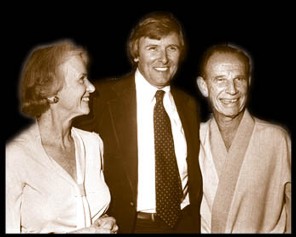 |

Jessica Tandy, D.L. Coburn, and Hume Cronyn
In The Beginning
The Gin Game was first produced in September of 1976 by American Theatre Arts in a 56-seat theater at the corner of Hollywood Boulevard and Argyle in Los Angeles. The Artistic Director of the theater was Don Eitner and the first director of the play was Kip Niven.
A favorable review in Variety brought the play to the attention of The Actors Theatre of Louisville where the play became one of the first offerings in its now famous festival of new plays. It was here that Jon Jory brought the play to the attention of Hume Cronyn and Jessica Tandy, who then sent it to Mike Nichols. Remarkably, Mr. Nichols signed on to direct within 24 hours, and the production destined for Broadway was formed.
In July of 1977, the play opened at the Long Wharf Theatre in New Haven, followed by an engagement at the Wilbur Theatre in Boston. On October 6, 1977, less than 13 months after the first performance before perhaps 50 people, The Gin Game opened on Broadway to rave reviews. It continued for 516 performances before going on triumphant tours of the United States, England and the Soviet Union.
To the right then, are some of the posters and programs from productions around the world that followed that initial Broadway production and continue to this day.
Thoughts on The Gin Game
Just days before the first production of The Gin Game years ago at a small theater in Los Angeles, I walked excitedly down Hollywood Boulevard looking for a newspaper stand so that I could read the first news account ever published about my new play. I couldn't wait as I nervously thumbed through the paper looking for the article I had heard would be there. And there it was. And within seconds I was literally running back to the theater caught between anger and dismay. As I burst into the tiny theater office my alarm poured forth: "They're calling my play a "comedy-drama," I shouted. "That's crazy! People are going to come here expecting to laugh."
And, of course, they did. But in my mind I had written a tragedy. Oh, I knew there were some funny moments, but I was deadly serious about the intense focus I was bringing to bear on two people who are nearing the end of their lives with many essential areas unexamined and never confronted. It is the gin game, gently at first, then as ferocious obsession, that draws both characters into a virtual death-spiral of revelation that reaches to the core of their beings. Yet, until late in the second act it is funny. And, indeed, some laugh until the end, despite the tragic undercurrent. A few years ago I came across something that helped me understand why.
In reading the letters of Gustave Flaubert, I came across the following phrase, tossed off easily as with many of his brilliant insights: "We laugh with pity at the vanity of the human will." That is why we laugh at The Gin Game. It is the human will that is funny. I simply stayed with the truth of my characters, life supplied the humor. Weller's rage against outrageous fortune is funny because we have all known such rage, and we know the futility of it. Yet Weller rages on. He may be defeated by Fonsia, but he will defeat God, because it is God who is giving her these cards. His own will be done. And by that will, the turn of the cards will change, auguring the change in his very fate he so desperately seeks. But, as with any attempt to transcend the limits of this realm, he is doomed. Therein lies the tragic element of the play and why it is now billed properly as a Tragi-Comedy in two acts.
— D.L. Coburn, September 1998
Original Broadway |
 Broadway Revival |
 London |
 Paris |
 Rome |
 Lisbon |
 Sweden |
 Japan |
 Amsterdam |
China |
 Israel |
|
All rights reserved. No portion of this document may be reproduced, copied or in anyway reused without written permission from D.L. Coburn.